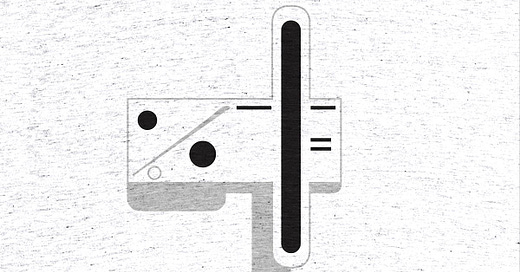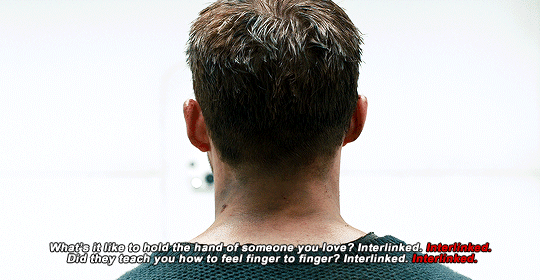Interlinked: How Does it Feel To Be a Cell Within Cells Within Cells
The Profound Significance of the ‘Cells Interlinked’ Scene in Blade Runner 2049
In Blade Runner 2049 there is this scene that is very minimalist but also holds profound significance both within the narrative and as an embodiment of the film’s artistic prowess. The scene in question is popularly known as the “cells interlinked“, an interrogation which serves as an anti-empathy assessment for replicants like K, the protagonist.
To fully grasp the importance of this scene, it’s essential to understand its multi-layered nature. On a plot level, the “cells interlinked” test functions as a means to ensure that replicants (something like an android or cyborg, if by some chance you haven’t watched the movie yet) do not develop emotional responses to their duty of eliminating other older generations of replicants. It cleverly reverses the original Blade Runner’s Voigt-Kampff test, which aimed to detect replicants lacking genuine human emotions. This role reversal adds a new dimension to the examination of artificial intelligence and hints that the passage of time did a 180° turn on that society.
Functionally, the test operates by interleaving portions of a pre-memorized “baseline” with emotionally provocative questions. K, played by Ryan Gosling, is required to swiftly repeat the words from his baseline when prompted, displaying his emotional composure. Any delays or stress in his responses indicate a deviation from his programmed nature of an unemotional executioner replicant, raising concerns about his allegiance and stability.
However, the significance of the “cells interlinked” test extends far beyond its plot mechanics. On a literary level, K’s baseline originates from the novel Pale Fire by Vladimir Nabokov. This literary work comprises a foreword, the poem itself, and an afterword, which offers an extensive and interpretive analysis of the poem. The foreword and afterword are attributed to a different author, who presents and dissects the poetic creation of a certain Mr. John Shade, for the reader.
From within the novel of Pale Fire, the specific passage chosen for Blade Runner 2049 captures the description of a near-death experience. Positioned approximately 700 lines into the poem, this evocative segment marks a pivotal moment within the narrative, with the poem stretching for several more lines beyond this profound encounter.
“I can’t tell you how
I knew – but I did know that I had crossed
The border. Everything I loved was lost
But no aorta could report regret.
A sun of rubber was convulsed and set;
And blood-black nothingness began to spin
A system of cells interlinked within
Cells interlinked within cells interlinked
Within one stem. And dreadfully distinct
Against the dark, a tall white fountain played.”
This literary reference acquires thematic weight, symbolizing K’s struggle with misinterpreted realities and misplaced purpose. Just as the protagonist in the poem later found out that he misinterpreted the vision of a white fountain as a sign of an afterlife, K mistakenly believes he is the chosen one. K dreamt of being a real boy. Both characters experience frustration and anger as a result of their misguided perceptions, highlighting the theme of distorted realities and the consequences they entail.
Moreover, the poem’s mention of interlinked cells alludes to K’s position within a vast interconnected system, underscoring his lack of autonomy and susceptibility to manipulation by higher authorities. This notion becomes evident as K prioritizes his work obligations over intimate connections, showcasing how external forces control and shape his actions. The film again plays with the idea of humans themselves being akin to robots, entangled in a web of societal and hierarchical influences.
The production process behind the “cells interlinked” scene further amplifies its impact. Initially, the scene was similar to traditional medical evaluation, with K being laid down and talking with a person, but it underwent significant transformations during the storyboarding phase. Director Denis Villeneuve, along with cinematographer Roger Deakins and concept artist Sam Hudecki, meticulously reimagined the scene’s design and placement. (interview @DenOfGeek)
During their collaborative sessions, which took place in a Montreal hotel room, Villeneuve and his team dissected the script, delving into the visual possibilities of each scene. These creative discussions resulted in the decision to create a more claustrophobic and impersonal environment for the test, intensifying its psychological impact. The visual choices made in this scene reflect the filmmakers’ vision of an oppressive future society and enhance the film’s overall atmosphere.
The scene’s evolution continued during the filming process, with input from Ryan Gosling himself. Gosling suggested incorporating a memory exercise employed by actors studying Shakespeare, in which specific words trigger associated memories. This transformed the scene into a more aggressive interrogation, with the examiner posing questions. This addition injected an additional layer of tension and showcased K’s ability to recall emotionally charged memories while maintaining his composure. The interrogator sounds more robotic than K.
By merging these various creative elements, the “cells interlinked” scene in Blade Runner 2049 reached its full potential as a pivotal moment in the film. Its unconventional nature, attention to detail, and collaborative effort emphasize the importance of creativity and experimentation in cinematic storytelling as an art form. This scene captivates the viewer through its thematic depth, visual precision, and psychological resonance.
We are invited to reflect on the implications of a world where humanity can be artificially replicated and cloned, questioning the nature of identity, empathy, and autonomy. The movie challenges us to ponder the blurred boundaries between human and artificial intelligence, the impact of external influences on our choices, and the fragility of our constructed realities and, given the fast-shifting world we’re living in with the rise of AI technologies at large, I often think about these themes.
In specific, this interrogation scene stands as a testament to the power of collaboration of ideas from different perspectives in storytelling and to visual craftsmanship, leaving a lasting impact on the audience, whether they perceive it or not. It’s impressive to see how in just under 2 minutes you can get a feel for the whole movie tone. The tension and thought-provoking nature of that section contribute to the film’s status as a modern sci-fi masterpiece, encouraging contemplation and sparking conversations on the complexities of our own human experience.






